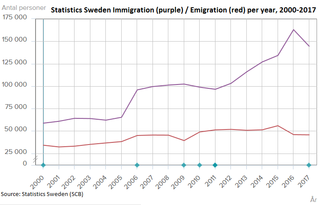
The demographics of Ethiopia encompass the demographic features of inhabitants in Ethiopia, including ethnicity, languages, population density, education level, health, economic status, religious affiliations and other aspects of the population.

The labor force is the actual number of people available for work and is the sum of the employed and the unemployed. The U.S. labor force reached a high of 164.6 million persons in February 2020, just at the start of the COVID-19 pandemic in the United States. Before the pandemic, the U.S. labor force had risen each year since 1960 with the exception of the period following the Great Recession, when it remained below 2008 levels from 2009 to 2011. In 2021, The Great Resignation resulted in record numbers in voluntary turn over for American workers.

The educational attainment of the U.S. population refers to the highest level of education completed. The educational attainment of the U.S. population is similar to that of many other industrialized countries with the vast majority of the population having completed secondary education and a rising number of college graduates that outnumber high school dropouts. As a whole, the population of the United States is spending more years in formal educational programs. As with income, levels differ by race, age, household configuration, and geography.

The Somali diaspora or Qurbajoogta refers to Somalis who were born in Greater Somalia and reside in areas of the world that they were not born in. The civil war in Somalia greatly increased the size of the Somali diaspora, as many Somalis moved from Greater Somalia primarily to Europe, North America, Oceania and South Africa. There are also small Somali populations in Asia. The UN estimates that in 2015, approximately 2 million people from Somalia were living outside of the country's borders.
Somalis in Finland are residents and citizens of Finland of Somali ancestry. As of 2023, 25,654 Finns had a Somali-background, making it the fourth most common foreign country of origin and the largest from Africa.

Health in Sweden has generally improved over time, with life expectancy increasing, and is at a high level in international comparison. Life expectancy in 2021 was 84.8 years for women and 81.2 years for men and it increased 2.3 years on average from 2006 to 2019. However, the health situation varies between groups in Swedish society and equitable health has proven to be a challenge, with level of education, employment status and country of birth being factors that strongly influence health in the Swedish population. The two leading causes of death in Sweden are cardiovascular disease and cancer.
Moroccans in Sweden are citizens and residents of Sweden who are of Moroccan descent.

Immigration to Sweden is the process by which people migrate to Sweden to reside in the country. Many, but not all, become Swedish citizens. The economic, social, and political aspects of immigration have caused some controversy regarding ethnicity, economic benefits, jobs for non-immigrants, settlement patterns, impact on upward social mobility, violence, and voting behaviour.
Indians in Sweden are citizens and residents of Sweden who are of Indian descent. Along with the Chinese, Indians are also one of the largest Asian immigrant populations in Sweden.

Somalis in Sweden are citizens and residents of Sweden who are of Somali ancestry or are Somali citizens. A large proportion of Somalis in Sweden emigrated to Sweden due to the Somali Civil War. Most Somalis in Sweden arrived to the country after the year 2006.
Syrians in Sweden are citizens and residents of Sweden who are of Syrian descent. As of 2019, there were 191,530 residents of Sweden born in Syria, and 50,620 born in Sweden with at least one Syrian-born parent. Sweden hosts the largest number of Syrian refugees outside of Middle East, aside of Germany.
Syrians in Denmark are citizens and residents of Denmark who are of Syrian descent.
Lebanese people of Denmark are people from Lebanon or those of Lebanese descent who live in the country of Denmark. The majority of Lebanese people came to Denmark in the 1970s and 1980s, either escaping the Lebanese Civil War or for economic reasons. Per 1 October 2016, 26,404 persons in Denmark were of Lebanese origin.
Eritreans in Sweden are citizens and residents of Sweden who are of Eritrean descent.
Eritreans in Norway are citizens and residents of Norway who are of Eritrean descent. Most have a background as asylum seekers that have fled Isaias Afwerkis regime.
Somalis in Norway are citizens and residents of Norway who are of Somali descent. They are the biggest African migration group in Norway. 36.5% of Somalis in Norway live in the capital Oslo. Almost all Somali in Norway have come to Norway as refugees from the Somali Civil War. In 2016, Somalis were the largest non-European migrant group in Norway.
Ethiopians in Norway are citizens and residents of Norway who are of Ethiopian descent.
Moroccans in Norway are citizens and residents of Norway who are of Moroccan descent.
Swedish Afghans are citizens and residents of Sweden who are of Afghan descent, part of the worldwide Afghan diaspora.
Moroccans in Denmark are citizens and residents of Denmark who are of Moroccan descent.








